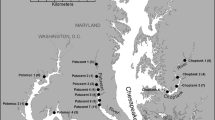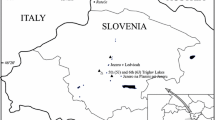Abstract
The results of a survey of the sediment chemistry of 7 East Anglian reservoirs are presented as part of a regional study on the assessment and control of eutrophication. The influence of water quality (dissolved oxygen, pH, temperature) on phosphate (PO4) adsorption by sediment from hypertrophic Ardleigh Reservoir is also examined. Extractable phosphate-P (extr.-P) varied between 92 and 383 mg kg−1 dry matter. Extractable P varied between 5.3 and 16.6% of the total phosphate-P (Tot. P) content and increased with the concentration of dissolved reactive phosphate-P (DRP) in the overlying water column. Organically complexed iron (organic Fe) was the determinand which correlated most closely with phosphate adsorption capacity, PAC (r = 0.8). Organic Fe was also related inversely to Extr. P. The rate and extent of PO4 adsorption by Ardleigh Reservoir sediment increased with the initial concentration of DRP and adsorption equilibria were reached after 24 h. The equilibrium DRP concentration, [DRP], was 0.7 mg P 1−1 under aerobic conditions indicative of a high potential for PO4 exchange. The rate and extent of PO4 adsorption was greater at 7 °C than at 22 °C PO4 adsorption increased markedly with dissolved oxygen status. Ardleigh sediment exhibited a marked buffering capacity to a change in pH; however, PO4 adsorption was greatest at an equilibrium pH of 5.6 and decreased progressively either side of this pH value.
Options for the artificial control of sediment PO4 release are discussed in relation to the seasonal variation in sediment PO4 exchange observed for Ardleigh Reservoir.
Similar content being viewed by others
References
Allen, S. E., H. M. Grimshaw, J. A. Parkinson & C. Quarmby, 1974. Chemical analysis of ecological materials. Blackwell Scientific Publications, Oxford.
American Public Health Association, 1976. Standard Methods for the Examination of Water and Wastewater. 14th edn., APHA, Washington.
Avery, B. W. & C. L. Bascomb, 1974. Soil survey laboratory methods. Soil Survey Technical Monograph. No. 6, Harpenden.
Bostrom, B., M. Jansson & C. Forsberg, 1982. Phosphorus release from lake sediments. Arch. Hydrobiol. 18: 5–59.
Bostrom, B. & K. Petterson, 1982. Different patterns of phosphorus release from lake sediments in laboratory experiments. Hydrobiologia 92: 415–429.
Department of the Environment 1972. Analysis of Raw, Potable and Waste Waters. HMSO, London.
Greene, L. A. & C. R. Hayes, 1981. The impact of eutrophication on water treatment and supplies in the Anglian Water Authority. J. Inst. Wat. Eng. Sci. 35: 421–437.
Gummerman, R. C. 1970. Aqueous phosphate and lake sediment interaction. Proc. 13th Conf Gt. Lakes Res. 673–682.
Hayes, C. R., 1978. Factors affecting the release of iron, manganese and some nutrients from flooded soils and reservoir sediments. M. Sc. thesis, University of Wales, Aberystwyth.
Hayes, C. R. & L. A. Greene, 1984. The evaluation of eutrophication in public water supply reservoirs in East Anglia. Wat. Pollut. Contr. 83: 42–51.
Holdren, G. C. & D. E. Armstrong, 1980. Factors affecting phosphorus release from intact lake sediment cores. Envir. Sci. Technol. 14: 79–87.
Hwang, C. P., T. H. Lackie & P. M. Huang, 1976. Adsorption of inorganic phosphorus by lake sediments. J. Wat. Pollut. Cont. Fed. 48: 2754–2760.
Jacobsen, O. S. 1977. Sorption of phosphate by Danish lake sediments. Vatten 33: 290–298.
Jorgensen, S. E. 1980. Lake management. Pergamon Press, London.
Klapwijk, S. P., J. M. W. Kroon & M. L. Meijer, 1982. Available phosphorus in lake sediments in the Netherlands. Hydrobiologia 92: 491–500.
Ku, W. C., F. A. DiGiano & T. H. Feng, 1978. Factors affecting phosphate adsorption equilibria in lake sediments. Wat. Res. 12: 1069–1074.
Lijklema, L. & A. H. M. Hieltjes, 1982. A dynamic phosphate budget model for a eutrophic lake. Hydrobiologia 91: 227–233.
McKeague, J. A., 1967. An evaluation of 0.1 M pyrophosphate and pyrophosphate-dithionite in comparison with oxalate as extractants of the accumulation products in podsols and some other soils. Can. J. Soil Sci. 47: 95–99.
McKeague, J. A., J. E. Brydon & M. M. Miles, 1971. Differentiation of forms of extractable iron and aluminium in soils. Soil Sci. Soc. Am. Proc. 35: 33–38.
McKeague, J. A. & J. H. Day, 1966. Dithionite- and oxalate-extractable Fe and Al as aids in differentiating various classes of soils. Can. J. Soil Sci. 46: 13–22.
McPherson, L. B., N. R. Sinclair & F. R. Hayes, 1958. Lake water and sediment. III. The effect of pH on the partition of inorganic phosphate between water and oxidised mud or its ash. Limnol. Oceanogr. 3: 318–326.
Norvell, W., 1974. Insolubilisation of inorganic phosphate by anoxic lake sediment. Proc. Soil Sci. Soc. Am. 38:441–445.
Organization for Economic Co-operation and Development, 1982. Eutrophication of waters. Monitoring, assessment and control. OECD, Paris.
Olsen, S., C. V. Cole, F. S. Watanabe & L. A. Dean, 1954. Estimation of available phosphorus in soils by extraction with sodium bicarbonate. U.S. Dep. Agr. Circular no. 939.
Redshaw, C. J., 1983. The effects of phosphorus control on reservoir eutrophication. Ph.D. thesis, University of Essex.
Ryding, S. O., 1981. Reversibility of man-induced eutrophication. Experiences of a lake recovery study in Sweden. Int. Revue ges. Hydrobiol. 66: 449–503.
Shukla, S. S., J. K. Syers, J. D. H. Williams, E. Armstrong & R. F. Harris, 1971. Sorption of inorganic phosphate by lake sediments. Proc. Soil Sci. Soc. Am. 35: 244–249.
Slater, S. J. E. & A. J. Boag, 1978. The phosphorus status of the sediments of three eutrophic lakes in Victoria. Aust. J. mar. Freshwat. Res. 29: 263–274.
Syers, J. K., T. D. Evans, J. D. H. Williams & J. T. Murdock, 1971. Phosphate adsorption parameters of representative soils from Rio Grande Do Sul, Brazil. Soil Sci. 112: 267–275.
Taylor, A. W. & H. M. Kunishi, 1971. Phosphate equilibria in stream sediment and soil in a watershed draining an agricultural region. J. Agr. Fd. Chem. 19: 827–831.
Welch, E. B., C. A. Rock, R. C. Howe & M. A. Perkins, 1980. Lake Sammamish response to wastewater diversion and increasing urban runoff. Wat. Res. 4: 821–828.
Williams, J. D. H., J. K. Syers, S. S. Shukla & R. F. Harris, 1971. Levels of inorganic and total phosphorus in lake sediments as related to other sediment parameters. Envir. Sci. Technol. 5: 1113–1120.
Williams, J. D. H., H. Shear & R. L. Thomas, 1980. Availability to Scenedesmus quadricauda of different forms of phosphorus in sedimentary materials from the great lakes. Limnol. Oceanogr. 25: 1–11.
Author information
Authors and Affiliations
Rights and permissions
About this article
Cite this article
Redshaw, C.J., Mason, C.F., Hayes, C.R. et al. Factors influencing phosphate exchange across the sediment-water interface of eutrophic reservoirs. Hydrobiologia 192, 233–245 (1990). https://doi.org/10.1007/BF00006018
Issue Date:
DOI: https://doi.org/10.1007/BF00006018




